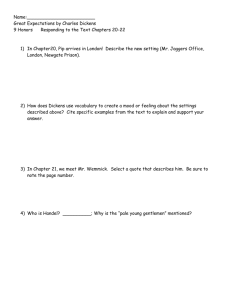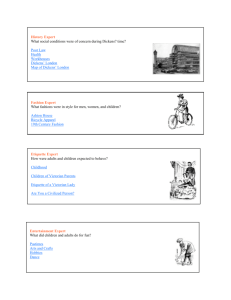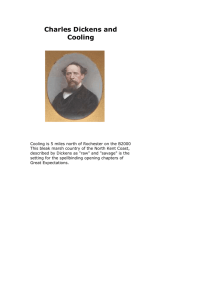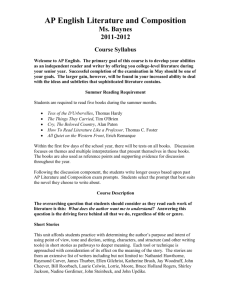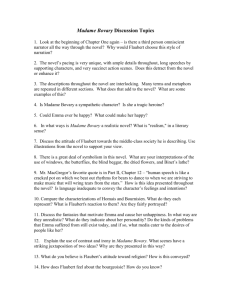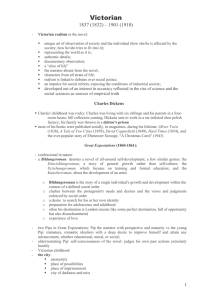Home and city in Dickens's Great Expectations and
advertisement
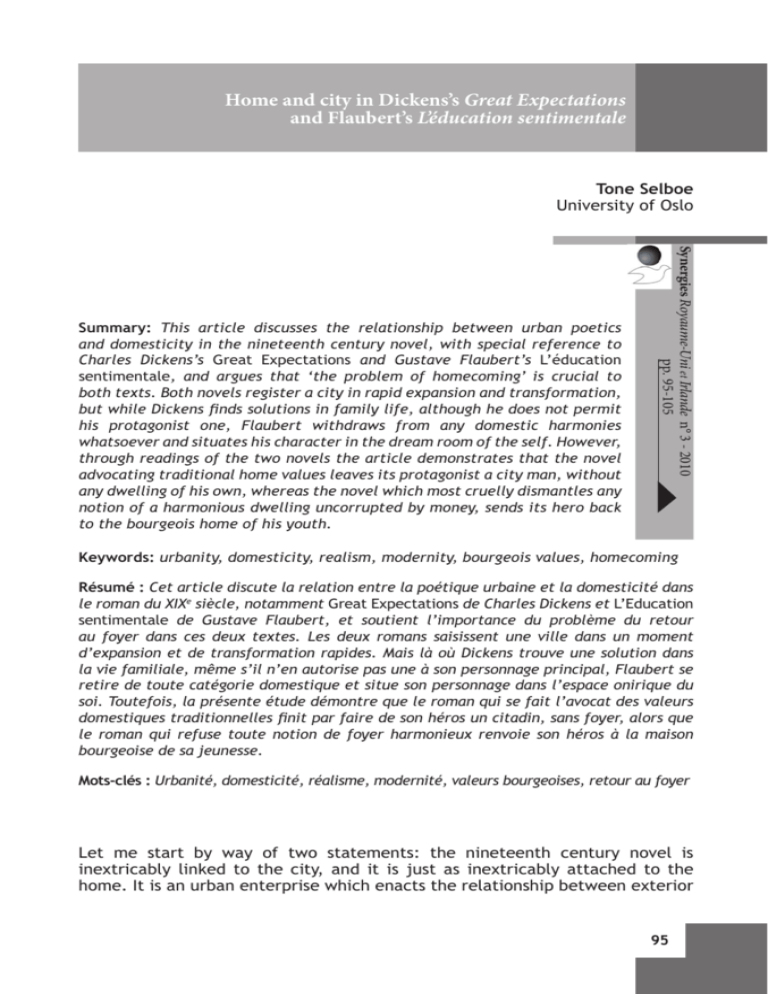
Home and city in Dickens’s Great Expectations and Flaubert’s L’éducation sentimentale Tone Selboe University of Oslo Synergies Royaume-Uni et Irlande n° 3 - 2010 pp. 95-105 Summary: This article discusses the relationship between urban poetics and domesticity in the nineteenth century novel, with special reference to Charles Dickens’s Great Expectations and Gustave Flaubert’s L’éducation sentimentale, and argues that ‘the problem of homecoming’ is crucial to both texts. Both novels register a city in rapid expansion and transformation, but while Dickens finds solutions in family life, although he does not permit his protagonist one, Flaubert withdraws from any domestic harmonies whatsoever and situates his character in the dream room of the self. However, through readings of the two novels the article demonstrates that the novel advocating traditional home values leaves its protagonist a city man, without any dwelling of his own, whereas the novel which most cruelly dismantles any notion of a harmonious dwelling uncorrupted by money, sends its hero back to the bourgeois home of his youth. Keywords: urbanity, domesticity, realism, modernity, bourgeois values, homecoming Résumé : Cet article discute la relation entre la poétique urbaine et la domesticité dans le roman du XIXe siècle, notamment Great Expectations de Charles Dickens et L’Education sentimentale de Gustave Flaubert, et soutient l’importance du problème du retour au foyer dans ces deux textes. Les deux romans saisissent une ville dans un moment d’expansion et de transformation rapides. Mais là où Dickens trouve une solution dans la vie familiale, même s’il n’en autorise pas une à son personnage principal, Flaubert se retire de toute catégorie domestique et situe son personnage dans l’espace onirique du soi. Toutefois, la présente étude démontre que le roman qui se fait l’avocat des valeurs domestiques traditionnelles finit par faire de son héros un citadin, sans foyer, alors que le roman qui refuse toute notion de foyer harmonieux renvoie son héros à la maison bourgeoise de sa jeunesse. Mots-clés : Urbanité, domesticité, réalisme, modernité, valeurs bourgeoises, retour au foyer Let me start by way of two statements: the nineteenth century novel is inextricably linked to the city, and it is just as inextricably attached to the home. It is an urban enterprise which enacts the relationship between exterior 95 Synergies Royaume-Uni et Irlande n° 3 - 2010 pp. 95-105 Tone Selboe and interior, between city and home. “In realism the real world is (…) excessively visible,” as Sara Danius has noted (Danius, 2006: 22), and the “visible world” of the realist novel is domestic as well as urban, or rather, the urbanity of the novel involves a reflection on domesticity. In the course of the nineteenth century cities are subject to rapid expansion and transformation, and this holds true for both London and Paris, perhaps even more so for the former than for the latter. Paris is often labelled, following Walter Benjamin’s much quoted words, the capital of the nineteenth century, but by the middle of the nineteenth century, London was the prime capital of the two – the financial and political centre. It was London which inspired Napoleon III’s plans to regulate the city of Paris, the process popularly known as the Haussmanization of Paris, and in terms of size, power and population London was the first metropolis. Between 1800 and 1900 London’s population rose to more than four million; that of Paris by comparison did not exceed one million before mid century (Freeman, 2007: 4). However, Paris had its revolutions which may account for the fact that political upheaval, and social mobility, seem to be more pressing issues in French novels than in English ones (Moretti, 2000). The response to the multitude of experiences offered by the city is hardly uniform. It may be argued that different cities engender different orders of prose, and different forms of “urban poetics”. Dickens’s Great Expectations (1860-61) and Flaubert’s L’éducation sentimentale (1869, hereafter Sentimental Education) will serve as my main examples when it comes to discussing the spaces of city and home as generative sites for literary realism. Both novels are centred on a young man coming to the city to make his fortune and find happiness, although in terms of plot and narration, the novels could hardly be more different. And yet the formative pattern of the Bildungsroman is in both novels fulfilled in a rather twisted way, and the relationship between the domestic and the urban is crucial when it comes to grasping the everyday world of the novels. Great Expectations and Sentimental Education are novels which – in all their diversity – offer an invaluable insight into the thinking about “the way we live now”. The ‘problem of homecoming’ may serve as an indicator of what is at stake. I will return to these texts in a moment, but first I will draw attention to a few elements concerning the question of housing, or dwelling, in the city. One way modernity is epitomized in the realist novel is as a tension between the interior and the exterior. Studies of Dickens in particular have been concerned with “the antithesis between the hearth and the city” (Welsh 1971: 143). In general, however, studies of city life in literary culture have mainly focused on streets, cafés and crowds, whereas the bourgeois home has attracted less critical attention (Sharon Marcus’s seminal study Apartment Stories: City and Home in Nineteenth Century Paris and London is a major exception). And as Diana Fuss has pointed out: “Modernity is simply another name for the reign of interiority, that moment in history where exteriority is driven indoors by the domesticating passions of the bourgeoisie.” (Fuss 2004: 12) The bourgeois subject invests time, money and energy in the home, to the extent that interiority may be seen “as a new ontological state,” according to Fuss (Fuss, 2004: 11). ‘The interior turn’ does not of course mean that exteriority is obliterated, but the 96 Home and city in Dickens’s Great Expectations and Flaubert’s L’éducation sentimentale increasingly busy city life requires its antidote: the haven of the private home, compartmentalized to fit its inhabitants’ various needs. This may be seen in light of the increasing interest in the individual and her interior life. From Heidegger to Bachelard, dwelling is seen as man’s fundamental condition. Gaston Bachelard’s phenomenological study La poétique de l’espace (1958) is a major work on the significance of house and home, and its driving force is the nostalgia for the happy dwelling, analyzed through readings of poetry. The tension between the happy dwelling and the unhappy, alienated situation linked to homelessness or the image of the haunted house is central to the nineteenth century novel. The nineteenth century novel’s reflection on “home” inevitably draws attention to its opposite: homelessness, unsettledness, and the haunted house; the opposition being well covered in the two German words: heimlich and unheimlich – the latter of course a central Freudian term known in English as the uncanny. The uncanny (even without going into the psychoanalytical implications of the term) is a key word for the modern condition, and the novel, being the modern genre par excellence, is inevitably embedded in and nourished by “uncanny” modernity. It is hardly surprising then that, when Georg Lukács in Theorie des Romans (1916) defines the modern condition as one of “transcendental homelessness”, he turns to the nineteenth century novel to argue his case, Sentimental education being his prime example of “romantic disillusionment”. In short, home, and its reverse, homelessness (a transcendental, sociological and phenomenological category), are essential elements of the urban condition. And it is precisely the ambiguity of dwelling which is at the core of Walter Benjamin’s writings on the city and its interiors. He sees the nineteenth century’s addiction to dwelling (Gebäude) as a craving for a safe interior, a shelter, but also as its opposite: confinement and suffocation. The individual in his dwelling, like an instrument embedded in its velvet case, contributes to the illusionary state of the modern condition, what Benjamin labels “the phantasmagory of the interior” (Benjamin, 1982: 292, and Fuss, 2004: 11). Benjamin’s analysis of the nineteenth century’s dealings with the interior is not limited to the private home, but demonstrates how even the street is interiorized (see his work on the Parisian arcades). Thus, one might argue that not only does domesticity pervade interior and exterior life, but also that one of the striking features of the nineteenth century is that the difference between exterior and interior itself is up for grabs – becoming an issue for protection as well as for obliteration. Needless to say, home, house, and dwelling have architectural features which can help to clarify a novel’s dealing with these questions. In the above mentioned Apartment Stories, Sharon Marcus differentiates between the architecture of Paris and that of London. Whereas Paris is dominated by apartment houses where people are separated and need not meet, London’s houses are modelled on villas and cottages and dominated by single-family homes. Thus, London, to a greater extent than Paris, introduces the countryside in the city. Marcus’s aim is not, however, to make a distinction between domestic and urban, but 97 Synergies Royaume-Uni et Irlande n° 3 - 2010 pp. 95-105 Tone Selboe rather to show the interaction between city and home – what she calls “the domesticity of Parisian urbanism and the urbanism of London’s domesticity” (Marcus, 1999: 4). Following Marcus’s argument, I will venture to show that, though the concept of home means different things to Dickens and Flaubert, both writers are firmly rooted in urban space. Confronting the multitude and chaos of the modern city, they nevertheless come up with drastically different answers. It is precisely the differences as well as the similarities in the treatment of domesticity and urbanism in Great Expectations and Sentimental Education which will be my topic here. Let us turn to Great Expectations first. In all his novels Dickens weaves together the urban and the domestic, two domains which have often been treated as antithetical. In Great Expectations these two categories are central to the way the protagonist Pip understands and perceives the world. The novel’s three main locations (his childhood home, Satis House and London) shape his life-journey, a journey embedded in a tension between the illusionary and the real, and the homely and the un-homely. Satis House is where his “great expectations” are raised, and the place is the incarnation of the uncanny if ever there was one, as far removed from the everyday existence as is possible. This is where he meets the mysterious Miss Havisham and the irresistible Estella, both women crucial to the design of the plot as well as to his development. This ancient and memory-ridden haunted house, where the present is abolished and its owner lives the life of a ghost, is the place of more fantasies and illusions than are ever attached to any other place or person in the novel. Although the convict Magwitch is from the very start invested with the “unreal”, coming and going in the middle of the night as he does, and initially more a character of the nightmare than the everyday, he eventually turns out to represent the reverse as well. In spite of being a criminal and a convict, he comes to play a part in Pip’s domestic circle. He is of course Pip’s secret benefactor, but to Pip the horror of this realization gradually gives way to an appreciation of his virtues. In the novel as a whole Magwitch bears the mark of the uncanny, but he also comes to stand for loyalty and love, much in the same way as Joe does – the main representative of positive parental values. Pip’s journey is a plot-driven journey within a hermeneutical system of signs taken for wonders, where self-delusion and misinterpretation are replaced by greater clarity and insight. Dickens makes the city the prime scene for learning the difference between appearance and reality. The seemingly chaotic city has a lesson to teach Pip – a lesson in realism, well captured in Mr. Jagger’s words: “Take nothing on its looks; take everything on evidence. There’s no better rule” (Dickens, 1999:251). London is on the one hand meeting his great expectations, it is where he sets out to be a gentleman; on the other it is the city of decline and fall, of bustling life and of murder and death, in other words, the dismantling of illusions, including his great expectations. On his first coming to London, Pip walks through Smithfield cattle-market before seeing Newgate prison, and the way Dickens incorporates the sensation of filth and dirt into Pip’s discourse demonstrates how vividly his perception of himself 98 Home and city in Dickens’s Great Expectations and Flaubert’s L’éducation sentimentale is informed by the place he inhabits: “the shameful place, being all a smear with filth and fat and blood and foam, seemed to stick to me” (Dickens, 1999:131). When he is given a tour of the gallows and whipping posts of Newgate prison, it “gives him a sickening idea of London” (Dickens, 1999:131), which he tries to get rid of by buying his way out for a shilling. Pip’s belief in the power of money, or rather the innocence of money as a means to a better life as well as a way of getting rid of the “dirt” of the past, will be thoroughly shattered in the course of his London years. London is a crude lesson in the nature of corruption, and life in the city precipitates debts and dealings, events and sudden encounters which eventually force him to renounce his fortune altogether. In London the poles of the domestic and the urban are epitomized by Jagger’s law office and Wemmick’s home, the office representing the discourse of the public and Walworth the discourse of the private, famously and comically represented by Wemmick’s statement: “No; the office is one thing, and private life is another. When I go into the office, I leave the Castle behind me, and when I come into the Castle, I leave the office behind me.” (Dickens, 1999:162)”. Dickens’s portrayal of home and family circles are of course well documented by Dickens scholars. Thus, Alexander Welsh writes: “Dickens’s portrayal of the clerk Wemmick in Great Expectations is meant to be humorous, yet nowhere in literature is the modern segregation of hearth and city, of personal life and business, so sharply and consciously drawn,” and he goes on to argue that “the home life of John Wemmick uncannily resembles that of today’s suburbanite” (Welsh, 1971: 143). The Victorian saying “An Englishman’s home is his castle”, a domestic ideology quoted so often it has almost lost its power of meaning, is portrayed as reality as well as parody in Wemmick’s Castle. “The Castle” is an emblem of the single-family home, “the smallest house I ever saw” (Dickens, 1999:160), and an autonomous unit ready to defend itself against a hostile environment, with a Union Jack, a drawbridge and a gun securing the “fortress”. Thus it parodies the notions of both “castle” and “home”. Although it is a dwelling for Wemmick and his Aged Parent, cosy and protective, it is also a vulnerable “castle”. The distance to the threatening river and all the dealings of London, represented by the office in Little Britain and the criminal underworld displayed on streets and corners, is short. When it comes to offer real protection it is obvious that it is just as insufficient as if it was placed in the middle of the city. In fact it is placed in the middle of the city, the distance between the two being mental and social rather than geographical. This rural abode situated right in the middle of an urban environment stalked by crime and death, turns out to be a more shaky hiding place than it appears at first; Magwitch can for instance not be sheltered there. Its closeness to the river underlines its unstable character. The text demonstrates that the family “castle” is hard put to serve as a model for society and urban modernity. Although “the ideal home” is friendly but openly parodied in Wemmick’s Walworth and thus represents no real alternative to urban chaos, it is implemented as a nostalgic and trustworthy alternative in Joe and Biddy’s home – a place safely removed from the urban setting. The common denominator between the two is that in both cases the values of home are protected, even when, as in Walworth’s case, the realization of 99 Synergies Royaume-Uni et Irlande n° 3 - 2010 pp. 95-105 Tone Selboe home is ambiguous. As a child Pip believed in the happy home in spite of his sister’s temper, because “Joe had sanctified it” and made him envisage “the best parlour as a most elegant saloon”, “the kitchen as a chaste though not magnificent apartment”, and “the forge as the glowing road to manhood and independence” (Dickens, 1999:86). After the meeting with Estella he starts feeling “ashamed of home”, and by implication Joe, and it is exactly this shame which is overcome in the end. Dickens projects the values of home life on to the urban realm and makes the conditions of domesticity – understood as love, safety and trust between family members – his socio-political ideal. What makes Great Expectations exceptional in Dickens’s oeuvre is the fact that Pip, the protagonist of the novel, is not allowed a final home. As Catherine Waters has pointed out, it is “a novel that is filled with defective parents and dysfunctional families (…)” (Waters, 1997: 152). One might say, however, that Great Expectations restores domestic values by Joe’s marriage to Biddy, which turns the unhappy home into a happy one. Joe’s apoplectic wife gets her sound replacement in the good woman Biddy, and Pip is “reborn” as their beloved son, presented to the reader through the grown-up Pip’s eyes. His narration moves between the nostalgic, the elegiac and the satirical: coming back intending to marry Biddy, he finds that it is indeed a wedding day – the marriage of Biddy and Joe is about to take place. In short, it isn’t his home anymore, despite the fact that they eventually all gather in their old positions: Pip ironically taking the detestable Mr. Pumblechook’s chair beside little Pip – “but I did not rumple his hair” (Dickens, 1999:356). Pip’s plot of identity, which starts on the novel’s first page, seems to end here. It is in other words a deeply ironic homecoming, and although Pip has acknowledged his mistakes and made amends for his errors, he cannot stay in his old dwelling place. His maturity belongs not to the marshes of Kent but to the business life of London. “London” comes to stand for more than the actual city, it is the grownup “world” – urbanity representing the present: maturity, modesty and work. Dickens leaves his protagonist in the bourgeois world, but postpones his final destiny. The two different endings of the novel, including the ambiguity of the revised version, makes the reader wonder whether Pip eventually does succeed in settling down with his beloved Estella or not. Thus Pip becomes a modern hero, left in the tense area between home and city, situated outside the phantasmagorical realm of day-dreams. By maintaining the idea of home while simultaneously refusing Pip a safe dwelling, Dickens settles Pip in the harsh light of the everyday. In a sense Great Expectations is one of the most realistic of Dickens’s novels; it dismantles the dream world and goes for modest reality and as a result avoids the happy ending of the fairy tale. The melodramatic and spectral elements which are undoubtedly there give way to realism and “modernity”. As a consequence, the perception of the city has changed too: from the perspective presented when Pip first arrives and sees the houses as looming monsters spying on him, and filth and dirt sticking to him, to the everyday and integrated business life he leads in the end as “third of the Firm”. There is no homecoming in Great Expectations; experiences cannot be unmade, and Pip has once and for all cut himself off from “home”. That is the true urbanism of Great Expectations. 100 Home and city in Dickens’s Great Expectations and Flaubert’s L’éducation sentimentale Flaubert doesn’t offer the sort of domestic values linked to parental figures that Dickens does, and his novel certainly has no ideal home to show for itself, not even as a postulate. Sentimental Education nevertheless deals with interiors and exteriors in a way which demonstrates that not only is the dream of intimacy closely linked to interior life – the beloved Madame Arnoux is invariably situated within heavily furnished rooms and represented by objects and visual details – but Frédéric himself spends a lot of time decorating and designing rooms, interiors and himself. There are a lot of interiors in Sentimental Education, but those connected with families and bourgeois values are all in the negative, pervaded by lies, greed and betrayal: Flaubert does not give his readers a positive vision of home. Where Dickens finds solutions in family life, although he does not permit the grown-up Pip one, Flaubert withdraws from any domestic harmonies and situates his main character in the dream room of the self. However, both novels gravitate towards impossible love, a passion steeped in the fantastic rather than the realistic. But whereas Dickens’s Pip actively pursues his Estella and would have married her if he could, Frédéric’s love for an older married woman is from the very start characterized by inaction and contemplation – love for love’s sake. Dickens portrays the ideal of the single-family home as a sort of cosy haven, even when making fun of it, while Flaubert’s Parisian apartments and salons are houses more than homes. Despite all their intimate details like shades and lamps, carpets and bedspreads, they are strangely impersonal and easily exchangeable, and the more affluent their owners are, the more this is so. Frédéric may value all the things belonging to Madame Arnoux – “homely objects lying about” like “shades of lacelike paper” (Flaubert, 2004:52) – and see her room as a peaceful expression of herself, but his aim is to invade not to preserve this room, in other words to destroy the home of which her room is a false but peaceful mask. And where Dickens portrays the bachelor rooms of Pip and Herbert as simple but harmonious due to the loyalty and love between their two inhabitants, Frédéric and Deslaurier’s shared rooms are well furnished but pervaded by conflict and disagreements. Sentimental Education starts and ends with a homecoming, in both cases rather an involuntary one. The boat in the opening scene which sends Frédéric back home, prefigures the novel as a whole. The home in question is Frédéric’s mother’s house in Normandy, a place which throughout the novel represents boredom, inactivity, and a place he yearns to get away from, the antidote to the Parisian world of money and eroticism. Frédéric, who is indeed the hero of inaction and indecision, with a leaning towards the romantic both in looks and mentality, nevertheless ends by living the life of a petit bourgeois: “il vivait en petit bourgeois” (Flaubert, 2004:497) – “on a very modest scale” (Flaubert, 2004:456) – not because he has been taught a lesson and realized the nature of capitalism and the corruption of money, but simply because he has wasted his inheritance and never ventured to make any choice or decision whatsoever. Unlike Pip, Frédéric never leaves the domain of the imaginary; realism has no firm grip either on him or on the novel at large. The hope for change, for moral improvements, is not Flaubert’s. His protagonist has to put up with an outer world dominated by the bourgeois, but his inner world is steeped in the romanticism of the Napoleonic age. 101 Synergies Royaume-Uni et Irlande n° 3 - 2010 pp. 95-105 Tone Selboe Flaubert captures the new and quickly changing reality in a language which activates the tension between on the one hand the city as event, history and plot, and on the other the individual’s mind. Paris is filtered through the double perspective of a narrator and a protagonist; where Great Expectations’s retrospective first person narration displays a tension between the older (and wiser) narrator retelling the story of his younger self, Sentimental Education is kept in the third person. To be more precise, Flaubert’s technique is a free indirect discourse which more often than not obscures who is actually seeing or thinking, Frédéric himself or the third person narrator. Franco Moretti makes the point that, in the homogenized bourgeois society of Flaubert’s contemporary France, “free indirect style reveals, not its power, but its impotence” (Moretti, 2006: 400). Thus, Flaubert’s technique may be said to be a logical consequence of a modernity where inactivity is the individual’s sine qua non, rather than merely the effect of a single man’s romantic dreams. In Sentimental Education Flaubert juxtaposes the violent actions of 1848 with the distanced and almost alienated gaze of its protagonist, who never perceives what he sees as real: confronted with this violence reality collapses, so that even the revolution becomes spectral and thus in a cruel way unreal. Any attempt to capture meaning and reality seems to be humiliated by events. In Flaubert even history becomes a spectacle, a sort of make-believe performance unable to leave the fictional domain, summarized in Frédéric’s reflection on the violent street scenes of 1848: “He felt as if he were watching a play” (Flaubert, 2004:337) /”Il lui semblait assister à un spectacle” (Flaubert, 2004:311). The novel not only reveals his inability to take part, it cruelly dismantles any notion of progress and change. The narration displays an exposure of violence which lays bare the brutal essence of modernity; it destroys the surface of civilization and demonstrates the dark side of bourgeois stability. Flaubert is a writer who investigates the moment in history when homely turns un-homely and shelterlessness becomes the collective historical condition. Cafés, student rooms and salons, boulevards and river, revolutions and riots, illusions and disillusion – all are woven into the image of Paris in the years just before and after 1848, the revolution of 1848 and the coup d’etat of 1851 being the novel’s historical centre of gravity. The human is exposed, torn out of his secure dwelling; the boulevard takes the place of the maternal home and becomes a site for dreaming, drifting and fighting. Pierre Bordieu has argued that Frédéric’s world, like the novel’s world, is torn between two socio-political poles; that of art on the one hand and that of business on the other, linked to the families of Arnoux and Dambreuse respectively (Bourdieu 1992: 21). I have already mentioned that the main interior of Sentimental Education is the mind of Frédéric himself, and by extension, the boulevard is metonymically linked to his phantasmagorical world. But it is also the site for violent riots, and thus the dividing line between exterior and interior is invariably blurred, like in the scene where Frédéric is waiting for Madame Arnoux to turn up for a rendez-vous at the same time as the workers start fighting. Her failure to meet him results in him seducing her husband’s mistress Rosanette instead, and the text moves between his erotic encounter and the street riot. There is no doubt 102 Home and city in Dickens’s Great Expectations and Flaubert’s L’éducation sentimentale which is the most “real” to Frédéric: “‘Ah! They’re killing off a few bourgeois,’ said Frédéric calmly. For there are situations in which the kindest of men is so detached from his fellows that he would watch the whole human race perish without batting an eyelid.” (Flaubert, 2004:306). Frédéric becomes more than an ambitious individual unable to work for his ambitions, he becomes an emblem of a generation as a whole. The main battleground, Frédéric’s mind, mirrors this generation stuck in a situation of passivity, a post-romantic situation bereft of hope; Frédéric’s lack of success has its counterpart in the revolution’s lack of success. Individual and collective history merge. Frédéric’s dreams of success come to nothing, and the workers’ revolution of 1848 ends in failure; with Napoleon III’s coup d’état in 1851 the dream of freedom is brutally crushed. Pip’s rise and fall has no such equivalence on the social level. Dickens, one might argue, retreats from the city’s social and political level to an individual level of right and wrong; there is no obvious connection between individual and social morality in Great Expectations. Although the criticism of money culture, capitalism and greed is certainly there, the moral battle between right and wrong is mainly worked out on the individual’s level. Through Pip’s existential journey, Dickens seems to simultaneously despise and embrace the values of bourgeois Victorian culture; criticizing the power of money while at the same time emphasizing the value of work. In Flaubert, by contrast, work doesn’t work any more. Sentimental Education is a novel of “silences” (Genette, 1966) and “still-lifescenes” rather than plot; words more than action; passivity and dreaming instead of development and Bildung. As such it is different from Great Expectations’ carefully drafted plotting of Pip’s journey towards greater knowledge of himself. Both novels involve a sentimental education in the most literal sense, in that both novels have to do with feelings. At the same time both writers avoid the sentimental by depriving their heroes of their “great expectations”. Irony renders a happy ending impossible in Flaubert and (at best) postponed in Dickens. Flaubert leans towards the modern(ist), Dickens towards the archaic. Historical transition is internalized and fragmented in Sentimental Education, whereas in Great Expectations, a pre-modern, archaic pattern serves to stabilize modernity’s disruptions. Dickens maintains both the heimlich and the unheimlich in scenes and settings which put the quotidian reality into perspective. He no doubt registers a city in rapid expansion and transformation, but there is an eeriness in his vision which makes him stand out. In terms of style and urban poetics, Flaubert merges realism with modernism, avant le lettre so to speak, while Dickens merges realism with the spectral and archaic. In Robert Alter’s words, Dickens “triggers certain primal fears and fantasies, archaic vision becoming the medium through which we are led to see the troubling meaning of the new urban reality” (Alter, 2005 :47). Sentimental Education benefits from a different hermeneutical system to Great Expectations. Although the plot of the latter is complicated and does not offer 103 Synergies Royaume-Uni et Irlande n° 3 - 2010 pp. 95-105 Tone Selboe a final solution to Pip’s life journey, it is true to say that the novel as such is plot-driven to a greater extent than Sentimental Education. Pip invariably tries to understand the system in which he is embedded; the world of Great Expectations is a hermeneutical system which lends itself to interpretation. The same may be said for other nineteenth century novelists like Balzac and Zola, Eliot and Trollope, to name but a few. Not so for Flaubert. The Paris of Sentimental Education to a greater extent resists interpretation. While Great Expectations has understanding as its goal and driving force, the “education” given in Flaubert’s novel gives no results and the world is not one to be understood. There is, however, a common denominator between the two novels, a “shifter” which may be labelled “chaos”. In Alter’s words: “Dickens shares with Flaubert an imaginative intuition that the rapidly expanding metropolis (…) was running out of control” (Alter, 2005: 54). In Dickens this intuition stays within the domain of story and plot, while in Flaubert it is rendered as a problem of perception and narration. The loss of meaning and the lack of understanding are compensated for by an emphasis on the protagonist’s imaginary world. If there is a home in Flaubert’s novel, something equivalent to a protected dwelling, it is a home of the mind, the imagination of the self. In Flaubert, the domesticism of the realist novel seems to be dismantled and has lost its ability to offer protection, but Frédéric does return “home” – Il revint. But what more effective dismantling of the whole idea of progress and individual development than the elliptical opening lines of part 3, chapter 6: He travelled the world. He tasted the melancholy of packet ships, the chill of waking under canvas, the boredom of landscapes and monuments, the bitterness of broken friendship. He returned home. (Flaubert, 2004: part 3, chapter 6) In Sentimental Education the protagonist has left the rational world of work and education behind, in short the whole world of the Bildungsroman, and exchanged it for passive contemplation where the possible, or should one say impossible, is more tempting than the real. Towards the very end of the novel, the two friends Frédéric and Deslauriers commemorate their youthful visit to the brothel La Turque – where courage failed them and the girls sent them off with laughter ringing in their ears – and they conclude: “That was the best time we ever had” (Flaubert, 2004:460). Dickens sends his hero away from his home ground and leaves him in the modern bourgeois world where domesticity is pushed to the margin. By contrast, Flaubert ironically sends his hero back home again, not to restore domestic realism or bourgeois values, far from it, but rather to save his protagonist from the cruel modernity of the city and reinstate him to his dream world. An inversion takes place: the novel advocating traditional home values leaves its protagonist a city man, without any dwelling of his own, whereas the novel which most cruelly dismantles any notion of a harmonious dwelling uncorrupted by money, sends its hero back to the bourgeois home of his youth. 104 Home and city in Dickens’s Great Expectations and Flaubert’s L’éducation sentimentale Bibliography Alter, R. (2005) Imagined Cities: Urban Experience and the Language of the Novel. New Haven: Yale University Press. Benjamin, W. (1982) Das Passagen-Werk 1. Band. Frankfurt am Main: Suhrkamp. Bourdieu, Pierre, 1992. Les règles de l’art: Genèse et structure du champ littéraire, Paris: Éditions du Seuil. Danius, S. (2006) The Prose of the World: Flaubert and the Art of Making Things Visible. Uppsala: Acta Universitatis Upsaliensis. Dickens, C. (1999) Great Expectations: A Norton Critical Edition. New York & London: W.W. Norton & Company. Freeman, N. (2007) Conceiving the City: London, Literature and Art 1870—1914. Oxford: Oxford University Press. Flaubert, G. (1972) L’éducation sentimentale. Paris: Libraire Générale Française. Flaubert, G. (2004) Sentimental Education. London: Penguin Classics. Fuss, D. (2004) The Sense of an Interior: Four Writers and the Rooms that Shaped Them. New York & London: Routledge. Genette, G. (1966) “Silences de Flaubert”, Figures: Essais. Paris: Éditions de Seuil. Lukács, G. (1971) Die Theorie des Romans: Ein geschichtsphilosophischer Versuch über die Formen der grossen Epik. Dramstadt und Neuwied: Hermann Luchterhand Verlag. Marcus, S. (1999) Apartment Stories: City and Home in Nineteenth century Paris and London. Berkeley and Los Angeles: University of California Press. Moretti, F. (2000) The Way of the World: The Bildungsroman in European Culture. London & New York: Verso. Moretti, F. (2006) “Serious Century”, The Novel, vol. 1: History, Geography, and Culture. Princeton & Oxford: Princeton University Press. Waters, C. (1997) Dickens and the Politics of the Family. Cambridge: Cambridge University Press. Welsh, A. (1971) The City of Dickens. Oxford: Clarendon Press. 105
